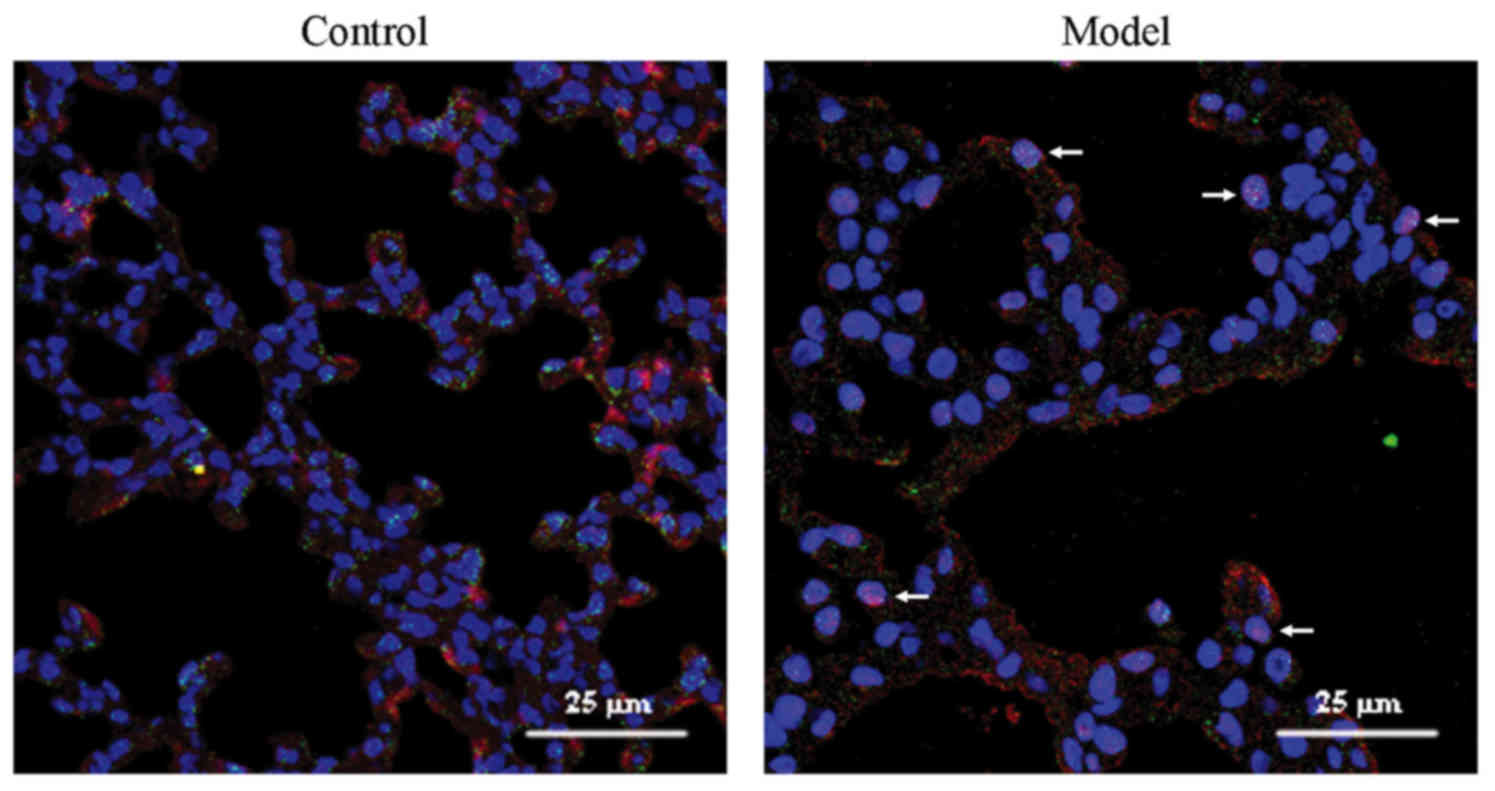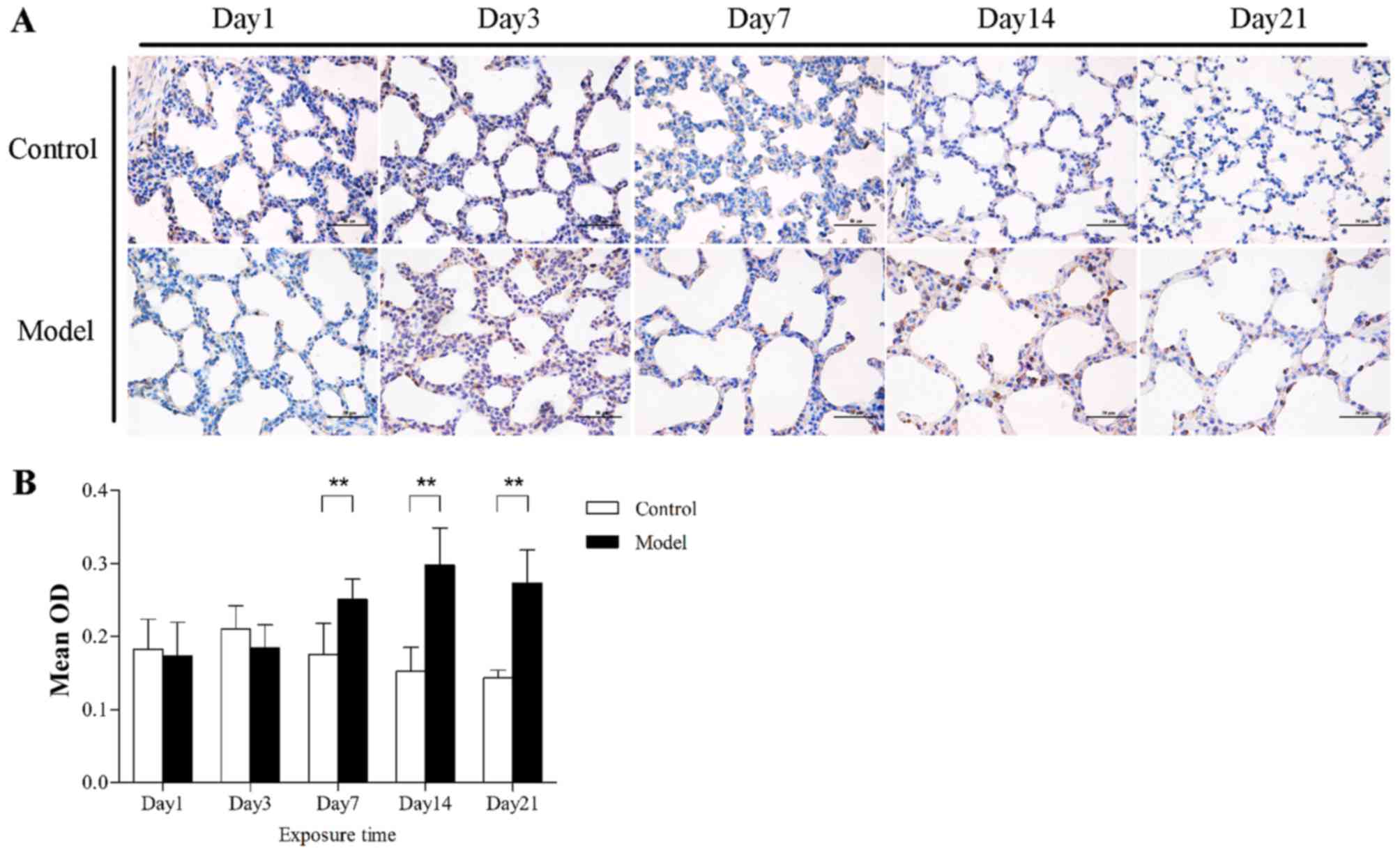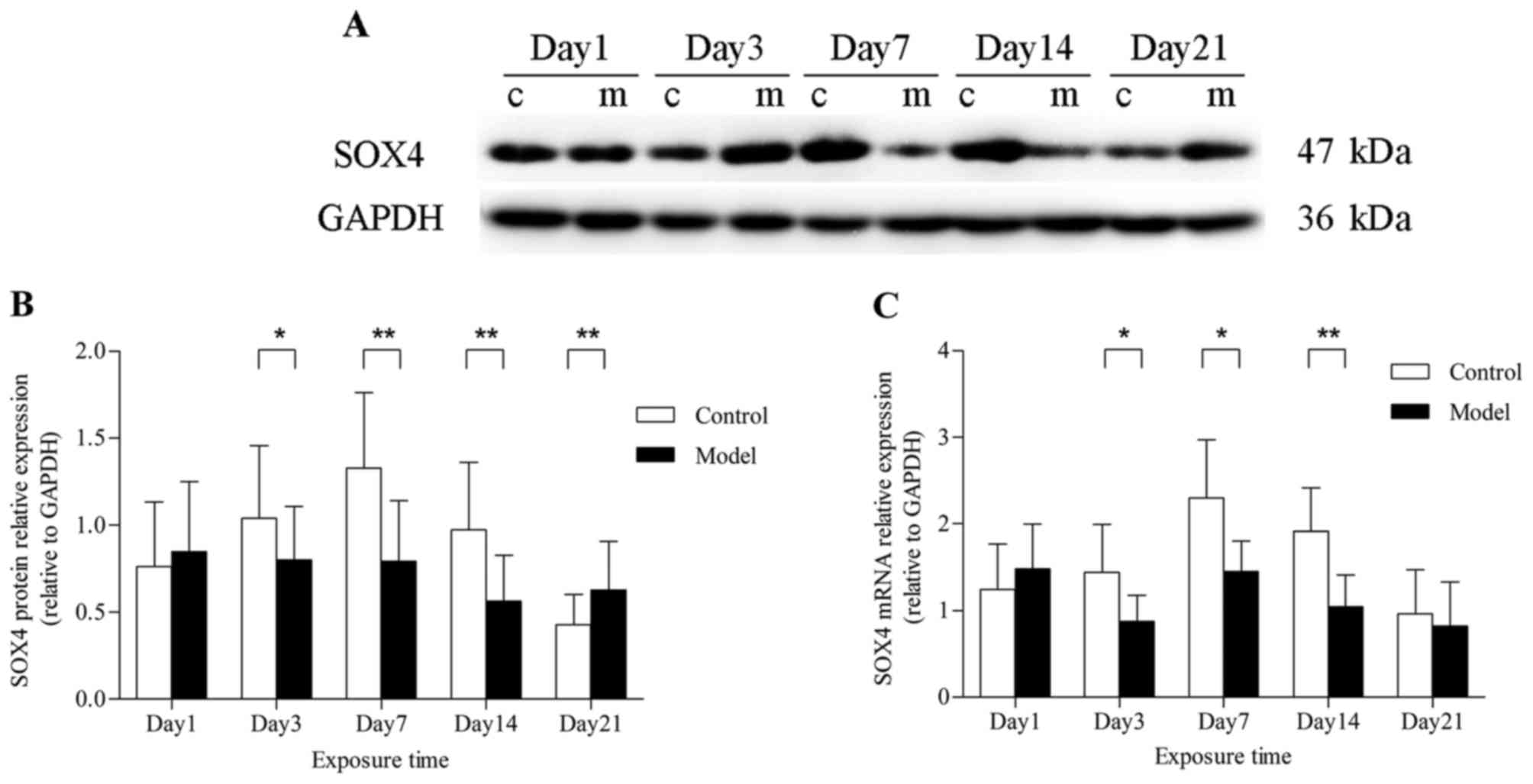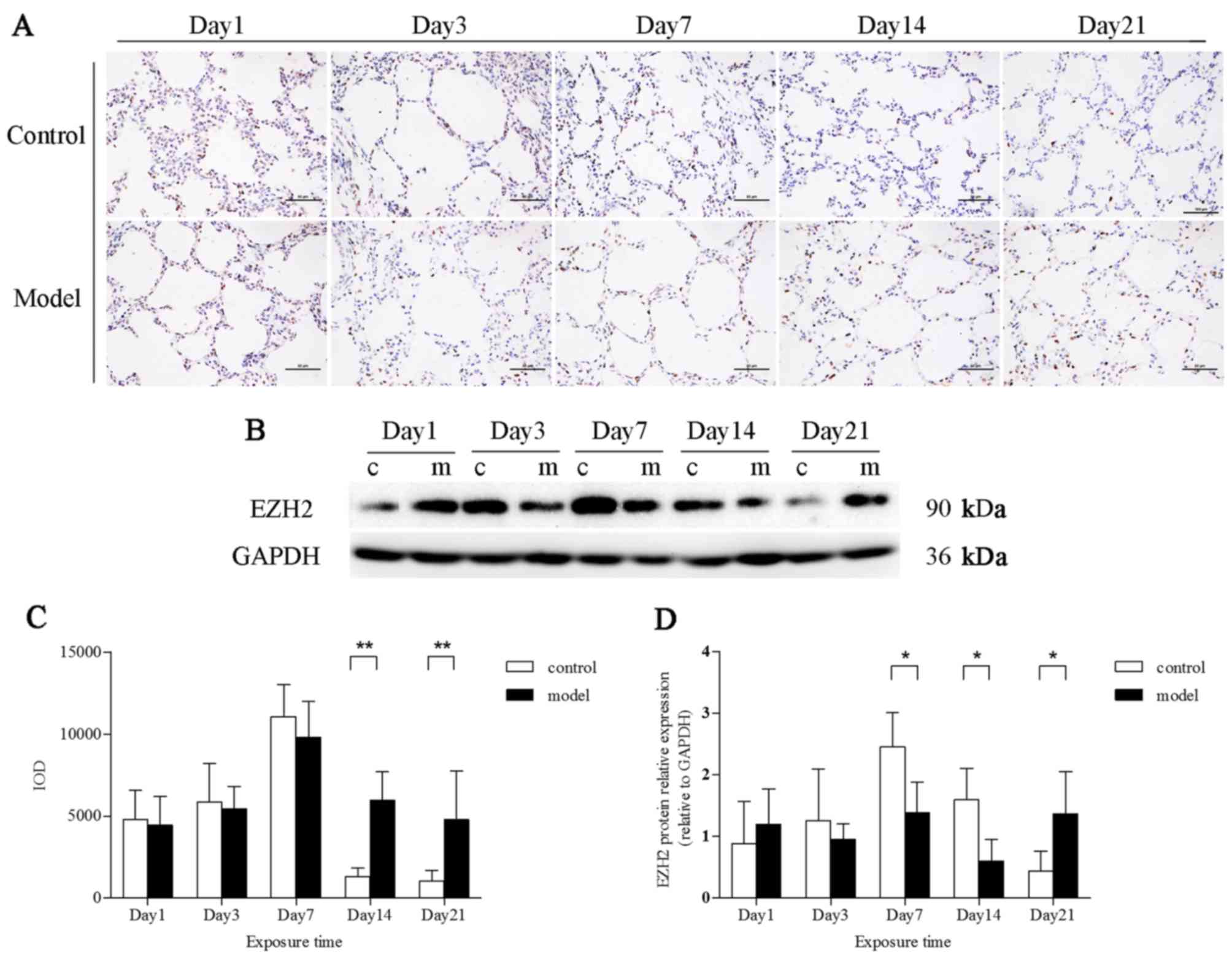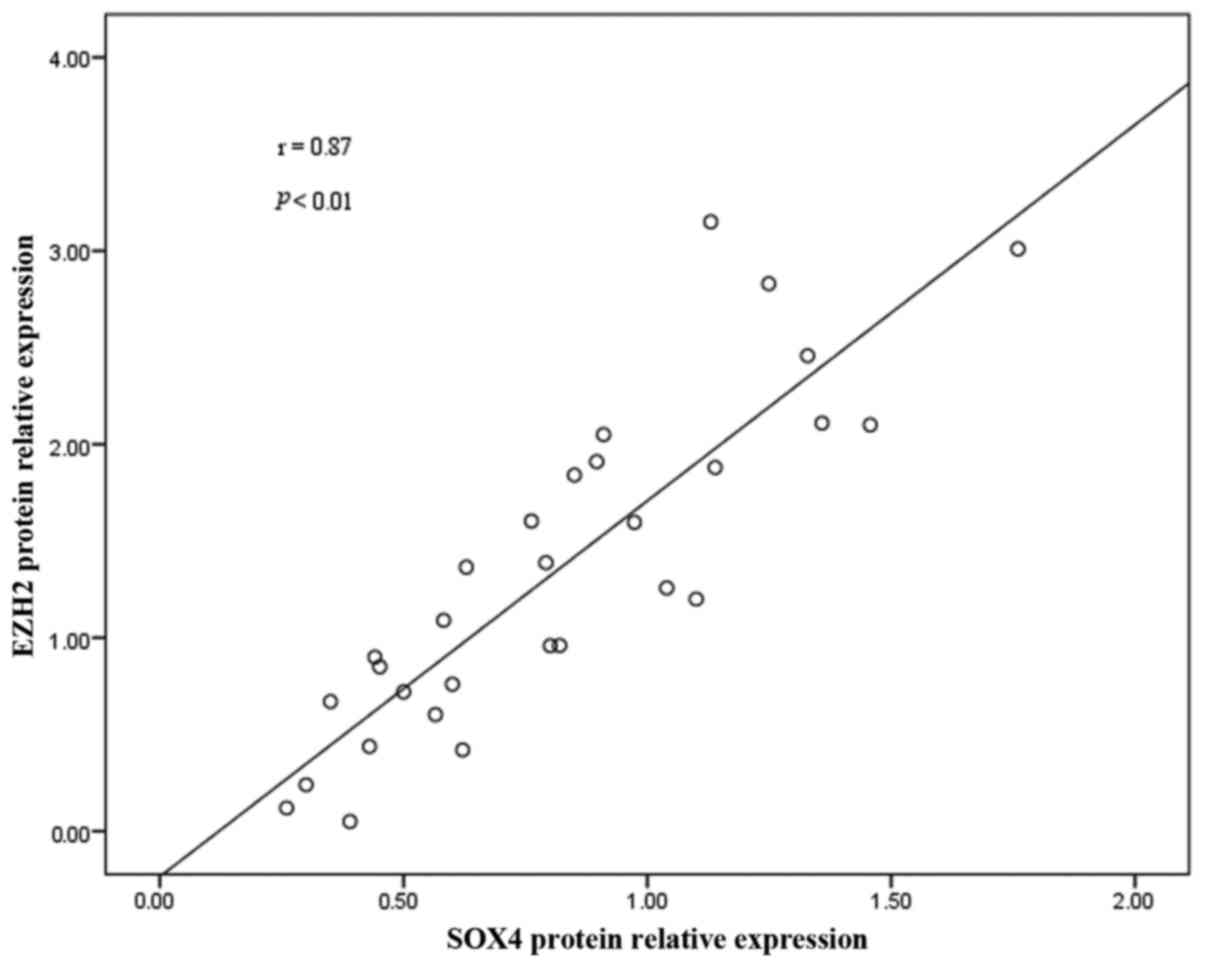SOX4 arrests lung development in rats with hyperoxia‑induced bronchopulmonary dysplasia by controlling EZH2 expression
- Authors:
- Published online on: October 3, 2017 https://doi.org/10.3892/ijmm.2017.3171
- Pages: 1691-1698
-
Copyright: © Pan et al. This is an open access article distributed under the terms of Creative Commons Attribution License.
Abstract
Introduction
Bronchopulmonary dysplasia (BPD) is a common chronic lung disease in premature infants. With the introduction of prenatal steroid use, progressive ventilator strategies, and improved survival of very low birth weight (VLBW) infants, the incidence of BPD has increased to as high as 68% among infants born at 22–28 weeks of gestation (1). These infants require re-admission to the hospital within the first 2 years after birth, and even as adolescents for lung function abnormalities consistent with increased incidence of asthma, chest deformities and pulmonary hypertension. Additionally, delayed neurodevelopment, particularly cerebral palsy, cognitive and motor function abnormalitites, are common in BPD infants; however, there is yet no effective and safe therapy for this condition (2).
'Old BPD', associated with prominent fibroproliferation, which was first characterized by Northway et al in 1967, is currently less striking. The more modern concept is that BPD is a disruption of distal lung growth, with prominent impaired alveolar and vascular growth, which has been defined as 'new BPD' (2). Mechanical ventilation and oxygen supplementation are major contributors to BPD (3). Unlike 'old BPD', patients with 'new BPD' may have been exposed to low inspired oxygen concentrations (2). Hyperoxia-induced inflammation, oxidative stress, apoptosis and cell death lead to disruption of lung development (4).
Epithelial-to-mesenchymal transition (EMT) is generally known as the process during which epithelial cells lose their polarity and junctions, and acquire the characteristics of mesenchymal cells (5). It was previously confirmed that hyperoxia induced type II cells in the lung to differentiate into fibroblasts through EMT, thus affecting alveolar development (6). This is associated with downregulation of RUNX3, a gene that is crucial for lung development. It was also demonstrated that the EMT occurring in the BPD model is associated with epigenetic modifications. Histone methyltransferase enhancer of zeste homolog 2 (EZH2), a key epigenetic modification regulator, was upregulated in type II cells in the model group and silenced the expression of RUNX3 through trimethylated H3K27 (7). SOX4, which belongs to the SRY-related HMG box gene family (8), is a master regulator during transforming growth factor (TGF)-β-induced EMT (9). More recently, selected studies have elucidated the role of the SOX4/EZH2 axis in epigenetic modifications during EMT (10,11). The aim of the present study was to determine whether dysregulated expression of SOX4 in the hyperoxia-exposed lung may contribute to EMT in BPD through EZH2.
Materials and methods
Animal model
All animal procedures were reviewed and approved by the Experimental Animal Ethics Committee of China Medical University. A total of 20 pregnant Sprague-Dawley rats (age, 8–10 weeks; weight, 200–250 g) were purchased from the Experimental Animal Center of China Medical University, and the BPD model was constructed as previously described. Briefly, newborn rats were randomly divided into two groups within 12 h of birth: The BPD model rats were exposed to 80–85% oxygen in a sealed Plexiglas tank for 1–21 days, while the control group rats were exposed to room air (21% oxygen). During this time, the oxygen concentration was continuously monitored with an oxygen analyzer and maternal rats were switched between the model and control groups every 24 h to avoid oxygen toxicity.
Lung tissue specimens
On postnatal days 1, 3, 7, 14 and 21, 8 pups in each group were anesthetized by intraperitoneal injection with 10% chloral hydrate, and the lungs were inflated with phosphate-buffered saline (PBS) at 20 cm H2O pressure; the lung tissues were then collected. The right middle lung lobes were fixed in 4% paraformaldehyde (PFA) for hematoxylin and eosin (H&E) and immunohistochemical staining; the remaining lung lobes were stored at −80°C for subsequent quantitative PCR (qPCR) and western blot analysis.
Lung histology
PFA-fixed lung tissues were dehydrated through graded alcohol and xylene, and embedded in paraffin. Subsequently, 4-μm sections were prepared for H&E staining for morphometric analysis. The radial alveolar count (RAC) provides a simple and relatively accurate assessment of lung development. According to the radial count method proposed by Emery and Mithal (12), alveoli transected along the perpendicular line from the center of the respiratory bronchiole to the nearest connective tissue septum or pleura, are enumerated. Image-Pro Plus 6.0 software (Media Cybernetics, Rockville, MD, USA) was used to measure the mean alveolar diameter (MAD) and alveolar septal thickness (AST). At least 5 fields were captured per section, and at least 20 alveoli were measured per field.
Double immunofluorescence
Following drying in a 60°C oven overnight, the tissue sections were deparaffinized in xylene and rehydrated in a gradient ethanol series. For antigen retrieval, the sections were microwaved in 10 mM citrate buffer (pH 6.0) for 20 min. The sections were then incubated in 5% bovine serum for 1 h at 37°C. A combination of two primary antibodies, rabbit polyclonal anti-SOX4 (SAB2108306; 1:100 dilution; Sigma-Aldrich Merck KGaA, St. Louis, MO, USA) and mouse monoclonal anti-p180 (ab24751; 1:50 dilution; Abcam, Cambridge, UK), was used for incubating the sections overnight at 4°C, while for negative controls PBS was used in the place of the antibody. The sections were then incubated with a mixture of two secondary antibodies, Alexa Fluor-594 donkey anti-rabbit IgG (ab150076; 1:500 dilution; Abcam) and Alexa Fluor-488 donkey anti-mouse IgG (ab150105; 1:500 dilution; Abcam) for 4 h at room temperature, followed by DAPI incubation for nuclear staining. Double immuofluoresence images were acquired using a confocal laser-scanning microscope (C1; Nikon, Tokyo, Japan).
Immunohistochemistry
Following deparaffinization and microwave heating, as previously described, the sections were treated sequentially with 3% H2O2 for 20 min to block endogenous peroxidase activity, and goat serum for 1 h at 37°C to block non-specific binding. The sections were incubated overnight at 4°C with SOX4 antibody (SAB2108306; 1:1500 dilution; Sigma-Aldrich) or EZH2 antibody (612666; 1:200 dilution; BD Transduction Laboratories, San Jose, CA, USA), then incubated with secondary antibody and streptavidin-horseradish peroxidase for 20 min. Finally, the sections were developed with 3,3′-diaminobenzidine and counterstained with hematoxylin. Antigen expression was assessed using an image analyzer (Image-Pro Plus 6.0; Media Cybernetics, Rockville, MD, USA).
Western blotting
Western blotting was performed using standard protocols. In brief, total protein was extracted from frozen lung tissue samples and mixed with loading buffer. Equal amounts of protein were separated by 10% sodium dodecyl sulfate-polyacrylamide gel electrophoresis (SDA-PAGE) (100 V for 3 h) and transferred to polyacryl-amide difluoride (PVDF) membranes (100 V for 50 min). Membranes were then blocked in 5% skimmed milk for 2 h at room temperature. Membranes incubated with rabbit anti-SOX4 (SAB2108306; 1:800 dilution; Sigma-Aldrich Merck KGaA) or mouse anti-EZH2 (612666; 1:1,000 dilution; BD Transduction Laboratories, San Jose, CA, USA) were shaken overnight at 4°C. The next day, the membranes were incubated with horseradish peroxidase-conjugated goat anti-rabbit or anti-mouse secondary antibody (1:5,000 dilution; Proteintech, Rosemont, IL, USA) for 2 h after washing three times in Tris-buffered saline and Polysorbate 20, and developed using enhanced chemiluminescence reagents (Thermo Scientific Pierce; Thermo Fisher Scientific, Waltham, MA, USA). Densitometry values were detected for all bands and standardized relative to glyceraldehyde 3-phosphate dehydrogenase (GAPDH) for each sample.
qPCR
Total RNA was extracted from the right lung lobes using TRIzol reagent (Takara Biotechnology Co., Kyoto, Japan) according to the manufacturer's instructions. Following purification according to the kit instructions, cDNA was reverse-transcribed from 1 μg RNA from each sample using Prime Script RT reagent kit with gDNA Eraser (Takara Biotechnology Co.). The primers were designed as follows: SOX4 forward, 5′-ATGTCCCTGGGCAGTTTCAG-3′ and reverse, 5′-TGCAATAGTCCGGGAACTCG-3′; GAPDH forward, 5′-AGACAGCCGCATCTTCTTGT-3′ and reverse, 5′-CTTGCCGTGGGTAGAGTCAT-3′. qPCR was performed using SYBR Premix Ex Tag (Takara Biotechnology Co.) on LightCycler (Thermo Fischer Scientific, Carlsbad, CA, USA); the amplification program was 95°C for 30 sec, 40 cycles of 95°C for 30 sec and 60°C for 34 sec. Relative mRNA expression of SOX4 normalized to GAPDH was determined by the 2−ΔΔCq method.
Statistical analysis
Statistical analysis was performed using SPSS 21.0 software (IBM, Armonk, NY, USA). Any significant difference between two groups was compared using an unpaired t-test, and correlation analysis was performed via Pearson's tests. All data are presented as mean ± standard deviation. P<0.05 was considered to indicate statistically significant differences.
Results
Prolonged hyperoxia disrupts lung development
Compared with the control group, the survival rate of rat pups exposed to hyperoxia was significantly decreased. As an important index of lung development, the RACs of the control group increased gradually, beginning on the day of birth. In pups exposed to hyperoxia for days, the RACs were significantly lower compared with those of the control group, particularly on days 7, 14 and 21 (Fig. 1B). Additionally, prolonged hyperoxia caused substantial morphological alteration of lung tissues. There was an increase in alveolar size in the model group, as quantified by an increase in MAD and AST, and the difference between the two groups was more pronounced with the prolongation of the hyperoxia exposure time (Fig. 1C and D). By contrast, no significant histological difference was found on days 1 and 3. Taken together, these results demonstrate that prolonged exposure to hyperoxia interrupts alveolarization, as demonstrated by a decreased number of alveoli and increased diameter and septal thicknesses of the alveoli.
SOX4 expression in alveolar type II cells exposed to hyperoxia
Double immunofluorescence was used to determine SOX4 localization. p180 is a lamellar body protein that is highly expressed in the lung, and plays an important role in the formation of pulmonary surfactant. Green p180 fluorescence represented type II cells. Co-expression of p180 and red SOX4 fluorescence appeared as orange. In the control group, only few cells co-expressed red SOX4 and green p180 fluorescence. By contrast, cells with red SOX4 fluorescence in the nuclei and green p180 fluorescence or orange co-expressed fluorescence in the cytoplasm were observed in the model group (Fig. 2).
SOX4 expression in rat lungs exposed to hyperoxia
To investigate whether hyperoxia altered the expression of SOX4 in rat lungs, immunohistochemistry, western blot analysis and qPCR were performed. After hyperoxia exposure for ≥7 days, SOX4 was localized to the nucleus as well as the cytoplasm of alveolar epithelial cells in the model group, but was poorly expressed in the control group (Fig. 3). The results differed, however, in total lung tissues. On day 1, the level of SOX4 expression was not different between the model and control groups, at both the mRNA and protein level. Furthermore, SOX4 protein expression was found to be downregulated after hyperoxia exposure for 3 days (P<0.05) and decreased markedly at 7 and 14 days (P<0.01). When hyperoxia exposure was prolonged to 21 days, the SOX4 protein expression in the model group, rather than decreasing, it was higher compared with that under normoxic conditions (P<0.01) (Fig. 4A and B). A similar effect on SOX4 mRNA expression was verified by qPCR analysis, but there was no significant difference at 21 days (Fig. 4C).
EZH2 expression in rat lungs exposed to hyperoxia
EZH2 was expressed in the nuclei of alveolar epithelial cells. After exposure to hyperoxia for 14 and 21 days, EZH2 expression was markedly upregulated (P<0.01) (Fig. 5A and C). However, the EZH2 protein levels in total lung tissues were downregulated in the model group at 7 and 14 days, as demonstrated by western blot analysis (P<0.01). EZH2 protein expression in the model group, compared with that in the control group, was increased at 21 days (Fig. 5B and D).
Correlation between SOX4 expression and EZH2 in rat lungs
To confirm the correlation between SOX4 protein expression and EZH2, correlation analyses were performed. EZH2 protein expression was found to be positively correlated with that of SOX4 (r=0.87; P<0.01) (Fig. 6).
Discussion
The etiology of BPD is multifactorial, and long-term mechanical ventilation is one of the primary risk factors increasing the incidence of BPD in VLBW infants, although it may decrease mortality in this patient population (13). In the present study, lower oxygen concentrations were used (80–85%) compared with those in previous studies (90–95%), and it was demonstrated that prolonged hyperoxia inhibited pulmonary development. There was a distinct morphological change: The alveoli decreased in number and were larger, more simplified, and displaying thickened alveolar septa in the model group, consistently with the pathological characteristics of 'new BPD'. The underlying mechanisms, however, remain largely unknown (2).
The alveolar epithelial surface is composed of alveolar type I and II cells. Type II cells comprise 16% of total lung cells and 60% of alveolar epithelial cells, which only cover 5% of the alveolar surface (14). Regeneration of the alveolar epithelium following lung injury is one of the major functions attributed to alveolar type II cells. Upon exposure to hyperoxia, type I cells are more susceptible to injury, and type II cells appear to increasingly proliferate and transdifferentiate into type I cells, which are resistant to oxidative damage (15). However, previous studies confirmed that hyperoxia inhibits activation of type II cells (16,17). A number of studies on the pathological foundation of BPD have focused on type II cell injury, with respect to proliferation, apoptosis and transdifferentiation into type I cells or mesenchymal cells (EMT).
EMT is accompanied by apparent changes in cell morphology and motility. As a physiological phenomenon, EMT is involved in embryogenesis, tumorigenesis and wound healing through cell signaling pathways, such as TGF-β/Smad and Wnt/β-catenin (18). It was previously demonstrated that alveolar type II cells underwent EMT in hyperoxia-induced BPD in newborn rats. Ultrastructural changes occurred in type II cells that differentiated into fibroblasts, followed by altered expression of E-cadherin, N-cadherin and α-smooth muscle actin (6). RUNX3 is a runt-domain transcription factor that plays a crucial role in lung development. In RUNX3 null mouse lungs, EMT markers are abnormally expressed, along with low levels of E-cadherin and high fibronectin expression (19). Our previous study confirmed that RUNX3 is downregulated in the hyperoxia-induced BPD model, which is attributable to EZH2-catalyzed histone methylation (7). EZH2, the histone methyltransferase, is a component of polycomb-repressive complex 2 (20). EZH2 epigenetically silences gene expression through the trimethylation of histone 3 lysine 27 (H3K27me3), and has been implicated in several types of cancer (11). However, the mechanism of EZH2 expression regulation in BPD is entirely unknown.
SOX4, a member of the group C subfamily of SOX transcription factors, plays an important role in embryogenesis and cell fate determination (21). SOX4 is important for lung development. Its expression is widespread in both the epithelium and the mesenchyme of the developing lung (22), with its expression in the bronchial duct epithelium being more abundant compared with that in surrounding lung tissues (23). During the canalicular period, SOX4 participates in transcription during differentiation of the conducting airway epithelium and affects lung morphogenesis (24). Its abnormal expression may cause various lung diseases. In non-small-cell lung cancer, SOX4 is overexpressed through 6p gene amplification and plays an important role in cancer progression and prognosis (25,26). The present study demonstrated that SOX4 expression increased during the early postnatal stages and decreased in the later stages in the control group, with lower expression in type II cells and higher expression in total lung tissues compared with the BPD group. The low proportion of type II cells in rat lung tissues, of which 46% and 30% are capillary endothelial and interstitial cells, respectively (14), may account for this result. This suggests that SOX4 dysregulation may be one of the causes of BPD.
SOX4 is a master regulator during TGF-β-induced EMT(9). In breast cancer, SOX4 is overexpressed and triggers EMT to promote tumor progression and metastasis (27). Ablation of SOX4 expression results in reduced expression of EMT inducers, such as Snail, Twist and Zeb (28). In the present study, SOX4 was upregulated in type II cells and may be associated with the occurrence of EMT in the BPD model. More recently, certain studies elucidated the importance of the SOX4/EZH2 axis in epigenetic modification during EMT (10,11). SOX4 directly regulates the expression of EZH2, which is involved in gene silencing via H3K27me3 modification in the promoters of target genes such as the epithelial marker E-cadherin (10,29). This study also revealed that EZH2 was upregulated in type II cells exposed to hyperoxia, and increased at a later time compared with SOX4. EZH2 expression increased, beginning 14 days after hyperoxia inhalation, while SOX4 increased after 7 days. Correlation analysis between SOX4 and EZH2 protein expression revealed a positive correlation. According to these findings, we hypothesized that upregulation of SOX4 in type II cells may promote EMT by modulating EZH2 expression, thereby disrupting alveolarization and lung development in BPD.
As lower expression of SOX4 in total lung tissues was observed in the model group, SOX4 may act through a different mechanism in other lung cells, such as fibroblasts. It was previously demonstrated that prolonged hyperoxia results in high BAX expression in fibroblasts and promotes apoptosis (30). Another study demonstrated that downregulated SOX4 expression induces apoptosis in lung cancer (31). Hur et al reported that the HMG box of SOX4 interacts with p53 and reduces p53 transcriptional activity on the BAX promoter, resulting in inhibition of p53-mediated apoptosis (32). Therefore, reduced SOX4 expression in lung tissues may relieve its inhibition of p53-mediated apoptosis and upregulate BAX expression, thereby promoting apoptosis of lung fibroblasts in the model group. Additionally, it has been confirmed that repressing EZH2 inhibits proliferation and induces apoptosis in cancer cells (33). Consistent with SOX4 expression, the expression of EZH2 in total lungs in the model group was also reduced; however, this reduction occurred later compared with that of SOX4, indicating that SOX4 may promote fibroblast apoptosis by regulating EZH2.
As EMT generates fibroblasts for wound healing and tissue regeneration (17), upregulated expression of SOX4 in type II cells may trigger epithelial cells to transdifferentiate into fibroblasts during oxidative epithelial injury repair. Downregulation of SOX4 in the early stages of hyperoxia in fibroblasts appeared to restrain the process of EMT against excessive fibroblast proliferation, and increased SOX4 expression in the later stages may indicate severe EMT that may lead to fibrosis, thus adversely affecting long-term prognosis. This hypothesis, which is consistent with lineage tracing studies showing that the number of fibroblasts transdifferentiated from epithelial cells is small, despite co-expression of epithelial and mesenchymal markers during human idiopathic pulmonary fibrosis (34), may be closer to the definition of the 'new BPD'. Otherwise, EMT of type II cells may interfere with their transdifferentiation into type I cells, leading to abnormal epithelial injury repair and, thus, affecting alveolarization. A study recently reported that SOX4 induction may be inhibited by caffeine, which has been used for BPD management (35). Thus, SOX4 may be a novel therapeutic target for BPD. Using caffeine during the early stages of BPD may downregulate SOX4 expression in the later stages, improving long-term prognosis.
In conclusion, the present study confirmed that the expression of the transcription factor SOX4 is increased in type II cells in BPD, but is reduced in total lung tissues. Dysregulation of SOX4 disrupts lung development in BPD by controlling EZH2 expression. However, further studies are required to determine the precise mechanism of action of SOX4 in BPD.
Acknowledgments
The present study was supported by grants from the Natural Science Foundation of China (nos. 81571479 and 81471489).
References
|
Baker CD and Abman SH: Impaired pulmonary vascular development in bronchopulmonary dysplasia. Neonatology. 107:344–351. 2015. View Article : Google Scholar : PubMed/NCBI | |
|
Kinsella JP, Greenough A and Abman SH: Bronchopulmonary dysplasia. Lancet. 367:1421–1431. 2006. View Article : Google Scholar : PubMed/NCBI | |
|
Baraldi E and Filippone M: Chronic lung disease after premature birth. N Engl J Med. 357:1946–1955. 2007. View Article : Google Scholar : PubMed/NCBI | |
|
Bhandari V: Hyperoxia-derived lung damage in preterm infants. Semin Fetal Neonatal Med. 15:223–229. 2010. View Article : Google Scholar : PubMed/NCBI | |
|
Lamouille S, Xu J and Derynck R: Molecular mechanisms of epithelial-mesenchymal transition. Nat Rev Mol Cell Biol. 15:178–196. 2014. View Article : Google Scholar : PubMed/NCBI | |
|
Yang H, Fu J, Xue X, Yao L, Qiao L, Hou A, Jin L and Xing Y: Epithelial-mesenchymal transitions in bronchopulmonary dysplasia of newborn rats. Pediatr Pulmonol. 49:1112–1123. 2014. View Article : Google Scholar : PubMed/NCBI | |
|
Zhu Y, Fu J, Yang H, Pan Y, Yao L and Xue X: Hyperoxia-induced methylation decreases RUNX3 in a newborn rat model of bronchopulmonary dysplasia. Respir Res. 16:752015. View Article : Google Scholar : PubMed/NCBI | |
|
Wegner M: From head to toes: The multiple facets of Sox proteins. Nucleic Acids Res. 27:1409–1420. 1999. View Article : Google Scholar : PubMed/NCBI | |
|
Vervoort SJ, van Boxtel R and Coffer PJ: The role of SRY-related HMG box transcription factor 4 (SOX4) in tumorigenesis and metastasis: Friend or foe? Oncogene. 32:3397–3409. 2013. View Article : Google Scholar | |
|
Tiwari N, Tiwari VK, Waldmeier L, Balwierz PJ, Arnold P, Pachkov M, Meyer-Schaller N, Schübeler D, van Nimwegen E and Christofori G: Sox4 is a master regulator of epithelial-mesenchymal transition by controlling Ezh2 expression and epigenetic reprogramming. Cancer Cell. 23:768–783. 2013. View Article : Google Scholar : PubMed/NCBI | |
|
Hasegawa S, Nagano H, Konno M, Eguchi H, Tomokuni A, Tomimaru Y, Asaoka T, Wada H, Hama N, Kawamoto K, et al: A crucial epithelial to mesenchymal transition regulator, Sox4/Ezh2 axis is closely related to the clinical outcome in pancreatic cancer patients. Int J Oncol. 48:145–152. 2016. View Article : Google Scholar | |
|
Emery JL and Mithal A: The number of alveoli in the terminal respiratory unit of man during late intrauterine life and childhood. Arch Dis Child. 35:544–547. 1960. View Article : Google Scholar : PubMed/NCBI | |
|
Jobe AH: The new bronchopulmonary dysplasia. Curr Opin Pediatr. 23:167–172. 2011. View Article : Google Scholar | |
|
Crapo JD, Barry BE, Gehr P, Bachofen M and Weibel ER: Cell number and cell characteristics of the normal human lung. Am Rev Respir Dis. 126:332–337. 1982.PubMed/NCBI | |
|
Castranova V, Rabovsky J, Tucker JH and Miles PR: The alveolar type II epithelial cell: A multifunctional pneumocyte. Toxicol Appl Pharmacol. 93:472–483. 1988. View Article : Google Scholar : PubMed/NCBI | |
|
Hou A, Fu J, Yang H, Zhu Y, Pan Y, Xu S and Xue X: Hyperoxia stimulates the transdifferentiation of type II alveolar epithelial cells in newborn rats. Am J Physiol Lung Cell Mol Physiol. 308:L861–L872. 2015. View Article : Google Scholar : PubMed/NCBI | |
|
Xu W, Xu B, Zhao Y, Yang N, Liu C, Wen G and Zhang B: Wnt5a reverses the inhibitory effect of hyperoxia on transdifferentiation of alveolar epithelial type II cells to type I cells. J Physiol Biochem. 71:823–838. 2015. View Article : Google Scholar : PubMed/NCBI | |
|
Pain M, Bermudez O, Lacoste P, Royer PJ, Botturi K, Tissot A, Brouard S, Eickelberg O and Magnan A: Tissue remodelling in chronic bronchial diseases: from the epithelial to mesenchymal phenotype. Eur Respir Rev. 23:118–130. 2014. View Article : Google Scholar : PubMed/NCBI | |
|
Lee JM, Shin JO, Cho KW, Hosoya A, Cho SW, Lee YS, Ryoo HM, Bae SC and Jung HS: Runx3 is a crucial regulator of alveolar differentiation and lung tumorigenesis in mice. Differentiation. 81:261–268. 2011. View Article : Google Scholar : PubMed/NCBI | |
|
Wang C, Liu X, Chen Z, Huang H, Jin Y, Kolokythas A, Wang A, Dai Y, Wong DT and Zhou X: Polycomb group protein EZH2-mediated E-cadherin repression promotes metastasis of oral tongue squamous cell carcinoma. Mol Carcinog. 52:229–236. 2013. View Article : Google Scholar | |
|
Penzo-Méndez AI: Critical roles for SoxC transcription factors in development and cancer. Int J Biochem Cell Biol. 42:425–428. 2010. View Article : Google Scholar : | |
|
Dy P, Penzo-Méndez A, Wang H, Pedraza CE, Macklin WB and Lefebvre V: The three SoxC proteins - Sox4, Sox11 and Sox12 - exhibit overlapping expression patterns and molecular properties. Nucleic Acids Res. 36:3101–3117. 2008. View Article : Google Scholar : PubMed/NCBI | |
|
Hoser M, Potzner MR, Koch JM, Bösl MR, Wegner M and Sock E: Sox12 deletion in the mouse reveals nonreciprocal redundancy with the related Sox4 and Sox11 transcription factors. Mol Cell Biol. 28:4675–4687. 2008. View Article : Google Scholar : PubMed/NCBI | |
|
Maeda Y, Davé V and Whitsett JA: Transcriptional control of lung morphogenesis. Physiol Rev. 87:219–244. 2007. View Article : Google Scholar : PubMed/NCBI | |
|
Wang D, Hao T, Pan Y, Qian X and Zhou D: Increased expression of SOX4 is a biomarker for malignant status and poor prognosis in patients with non-small cell lung cancer. Mol Cell Biochem. 402:75–82. 2015. View Article : Google Scholar : PubMed/NCBI | |
|
Medina PP, Castillo SD, Blanco S, Sanz-Garcia M, Largo C, Alvarez S, Yokota J, Gonzalez-Neira A, Benitez J, Clevers HC, et al: The SRY-HMG box gene, SOX4, is a target of gene amplification at chromosome 6p in lung cancer. Hum Mol Genet. 18:1343–1352. 2009. View Article : Google Scholar : PubMed/NCBI | |
|
Vervoort SJ, Lourenço AR, van Boxtel R and Coffer PJ: SOX4 mediates TGF-β-induced expression of mesenchymal markers during mammary cell epithelial to mesenchymal transition. PLoS One. 8:e532382013. View Article : Google Scholar | |
|
Parvani JG and Schiemann WP: Sox4, EMT programs, and the metastatic progression of breast cancers: Mastering the masters of EMT. Breast Cancer Res. 15:R722013. View Article : Google Scholar : PubMed/NCBI | |
|
Cao Q, Yu J, Dhanasekaran SM, Kim JH, Mani RS, Tomlins SA, Mehra R, Laxman B, Cao X, Yu J, et al: Repression of E-cadherin by the polycomb group protein EZH2 in cancer. Oncogene. 27:7274–7284. 2008. View Article : Google Scholar : PubMed/NCBI | |
|
Hu Y, Liu X, Zhang H, Fu J and Xue X: dynamic changes of Bax/Bcl-2 expression in lung tissue and fibroblasts of neonatal rats after inhaling high concentration oxygen. J Appl Clin Pediatr. 26:589–592. 2011. | |
|
Zhou Y, Wang X, Huang Y, Chen Y, Zhao G, Yao Q, Jin C, Huang Y, Liu X and Li G: Downregulated SOX4 expression suppresses cell proliferation, metastasis and induces apoptosis in Xuanwei female lung cancer patients. J Cell Biochem. 116:1007–1018. 2015. View Article : Google Scholar : PubMed/NCBI | |
|
Hur W, Rhim H, Jung CK, Kim JD, Bae SH, Jang JW, Yang JM, Oh ST, Kim DG, Wang HJ, et al: SOX4 overexpression regulates the p53-mediated apoptosis in hepatocellular carcinoma: Clinical implication and functional analysis in vitro. Carcinogenesis. 31:1298–1307. 2010. View Article : Google Scholar : PubMed/NCBI | |
|
Xie L, Zhang Z, Tan Z, He R, Zeng X, Xie Y, Li S, Tang G, Tang H and He X: MicroRNA-124 inhibits proliferation and induces apoptosis by directly repressing EZH2 in gastric cancer. Mol Cell Biochem. 392:153–159. 2014. View Article : Google Scholar : PubMed/NCBI | |
|
Kage H and Borok Z: EMT and interstitial lung disease: A mysterious relationship. Curr Opin Pulm Med. 18:517–523. 2012.PubMed/NCBI | |
|
Pan X, Zhao J, Zhang WN, Li HY, Mu R, Zhou T, Zhang HY, Gong WL, Yu M, Man JH, et al: Induction of SOX4 by DNA damage is critical for p53 stabilization and function. Proc Natl Acad Sci USA. 106:3788–3793. 2009. View Article : Google Scholar : PubMed/NCBI |




